
In the River KATSURA --Vol.101--

A Storm of Insects
A month later, in the beginning of July, I came to Kawamo, aiming for big fish. A lot of sedges had been emerging since spring and now more and more numbers. In the evening incomparably larger number of sedges were flying on the surface than the previous year. Probably emergence in the area reached a peak on that day. Many swarms of sedges had been seen since early evening here and there. Then when the sun set behind the mountains a storm of sedges suddenly hit the area. Countless sedges were flying vigorously on the whole banks like a snowstorm, which made the visibility bad. It was the heaviest storm of emerging sedges I had seen in some years. Then most of them started flying down and the rest of them coiled around the trees along the river like columns of mosquitoes.As usual I went upstream and returned here at the right time. I was just upstream of the descending spot to the bank. In front of me was the deep pool which had made the greatest performance in the area. In the previous year it was just a long slim channel but now changed into a conical pool. The opposite bank formed a sheer cliff and the heart of the stream flowed along there. There was a little whirling part at the lower reaches of a slightly jutting-out rock. Since I first saw this deep pool in spring, I had expected it to be the best point this year. I guessed so because it had almost the same shape as the pool at the upper reaches of S-shaped bend in the River Oshino, where I had caught many big fish. Furthermore, this deep pool lied in a perfect place between the barrier of Kawamo downstream and the water-draining mouth upstream.

Most brown trout were caught on the day when countless sedges had been emerging.
Under the Branch
It was a really attractive pool and one more thing made it perfect. There was a tree over the whirling part near the opposite bank. Although it was a little shrub like a miniature tree that clung to the cliff, it was a good mark for sedges to coil around because there was nothing but rocks there.Sedges (Long-barbelled giant sedges) gather on a mark on the bank. In many cases, on a tree on the waterside. If there are a few trees most sedges will gather together there. If there is no tree they will gather on tall grass or a big rock. If there is nothing but an angler, he will be a mark for sedges. As sedges are coiling around the angler walking on the bank, they are even called a nuisance in some districts. So we have to pay attention to a tree or a rock on the waterside of the monotonous bank because fish recognize it as a welcome spot of bait.
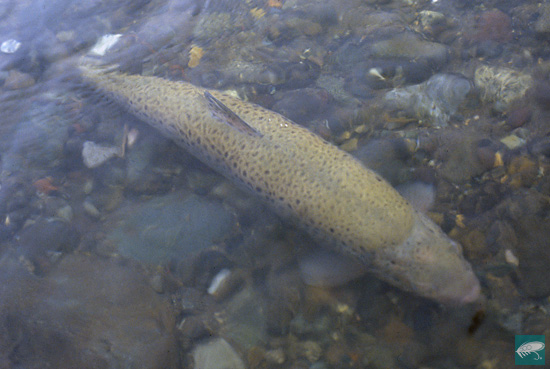
The fish’s fatness shows what nutritious values sedges have.
A surprisingly large number of sedges suggested that this was the right spot. At least this spot would not disappoint me. Thinking in this way, I stood in front of the deep pool. As expected, more than 50 sedges were coiling around the little tree on the opposite bank. Flying up and down in turn, they gradually moved near to the surface. Fish must come soon! Look, the surface has split! Probably, one more fish came into the whirling part under the branch.
My guess was right. Now I prayed it was a big fish. I walked near to the waterside and reeled out the line, watching the second rise very near me. It was only 10m away. It was still light and I had a lot of time. I felt that I almost caught the fish. As far as I made no blunder, I would enjoy fighting with it. Blunder means that I cast too early or I hook a jutting-out branch of the miniature tree.
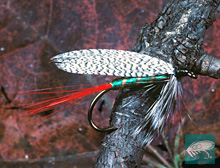
Grizzly King, one of the patterns which performed as greatly as Dunkeld.
I decided to cast the fly at the next rise. Immediately there was the 3rd rise. Unfortunately sunbeam prevented me from looking into the water. If I had looked at the river directly overhead, I would have seen the fish rising from the bottom. I let go of the leader from my left hand and cast Dunkeld, the same fly as the previous time, into the whirling part carefully. Waiting impatiently, I felt an electric shock from the rod like fish’s bite. My heart was beating. But it turned out that flying sedges hit my rod.
Chumming the Fish
The whirling part was only 1m wide and the heart of stream flowed in front of it. Therefore, the line drew out the fly from the spot within 5 or 6 seconds after it once settled. I thought that it was long enough for the small point. I picked up the fly from the surface. At the next moment a rise was made at the spot where the fly had just been drifting! A swarm of sedges that had been coiling around the branch was coming down on the surface.The fish was mad about sedges. It made rises quite often to devour sedges. But I got worried. At first I thought I had no bite because my casting timing was not fit for rise or because it was a little bit too light. But something was wrong. My fly drew no attention, no matter how many times I cast, whereas the fish made rises to real sedges more than 5 or 6 times. As the water level became lower, I changed Dunkeld of size 4 into size 6. Why do I get no bite? A smaller size of the fly was wrong? Or because too many real sedges were floating on the surface? I was irritated.
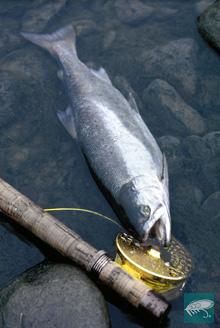
Yamame trout in March or April often had a shape of smolt.
When I fished in the sea I saw sea tuna or trevally crazily attacking a swarm of sardine. It sounded a good chance for anglers but a too big swarm of sardine made the fish lose interest in fly. The same thing happened when sardine were scattered from the boat to gather fish nearby. Too few sardine had no effect on gathering fish but too many made the fish eat only sardine but not the fly. Now too many chumming are scattered here!
I wondered when my chance would come. After sedges stop flying, after it gets darker or after rises stop? No, just waiting is not a good idea. The fish might sleep when it ate a lot. Should I change the fly? Usually I never upset even when the fish did not bite the fly soon after it made rises. But this was the perfect point and the fish ate a lot of sedges with splash. I could not wait patiently. Surely it is not an ordinary fish! What a big trophy is it?
The fish paid no attention to my fly for long. I calmed down again. Something was wrong. The fly looked perfect but actually was worse than real sedges. What is different? Sedges swim by themselves whereas the fly is made to flow in a natural-drifting way. To make the fly stay in the whirling part as long as possible, I raised the rod high and prevented the line from coming into the heart of stream in front of me. Consequently it was possible that the leader loosened and the fly style and its drifting way looked strange in a complicated flow.
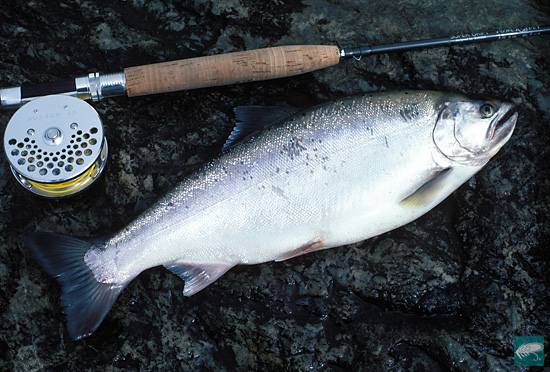
An amago trout with slightly reddish marks and Power Spey, a rod for wet fly produced in 1985.
I moved a little downstream. I wanted to go upstream but if I had done so, the line would have caught the jutting-out branch. Here I could cast the fly without touching the branch although fly-drifting way got worse. Knowing the disadvantage, I moved downstream and extended the line towards the branch tip carefully. The line end extended just under the jutting-out branch and sent the fly to the edge of the opposite bank, where no fish was staying. Immediately I raised the rod and tightened the line to make the fly pulled into the whirling part. The fly will be there for 2 or 3 seconds! The fish must find the creature that plunged into the water from the bank and swam to the whirling part!
The line was pulled with a shock with thud and straightly extended into the bottom. It was very near but a long length of the fly line was stuck into the water. It was much deeper than I had expected or the bottom was scooped a lot under the cliff. The fish that snatched the fly swung its body for a while but did not move at all. Almost the same pulling as the brown trout I caught a little upstream in June!
More than 5 minutes passed. I moved the rod to the left hand because my right hand felt paralyzed. A few minutes later my left hand got numb, too. Moving the rod from right to left and from left to right, I waited for the fish to get fatigued. Nearly 10 minutes later our fighting was over. Losing stamina, the fish suddenly became calm and rose from the bottom at my feet. It was a very fat brown trout that stayed at the slow-flowing deep pool, avoiding the fast current, and kept eating sedges every day.
-- To be continued --
- NET SHOP INFORMATION
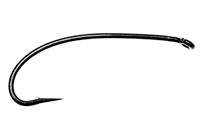
SL6 Black Spey Hooks
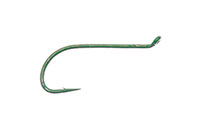
DU3 Limerick Spinner Hooks
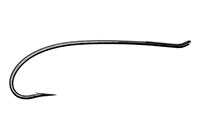
SL4 Single Bartleet Hooks
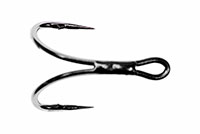
XD1 Tube Fly Double Hooks
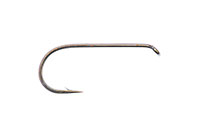
DD2 Flat Perfect Hooks
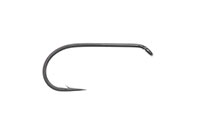
DD1 Black Terrestrial Hooks
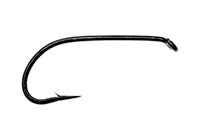
TD4 Old Limerick Wet Hooks
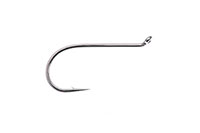
DU1 Silver May Hooks
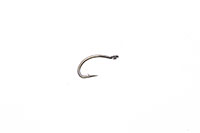
MU1 Flat Midge Hooks
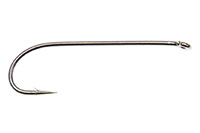
LD3 Long Limerick Hooks
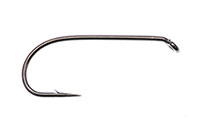
TD2 Summer Sproat Hooks
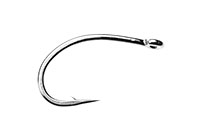
XS1 Tube Single Silver Hooks
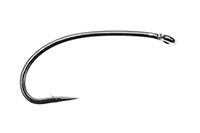
TD6 Siver Sedge Hooks

SL5 Black Spey Hooks

DU3 Limerick Spinner Hooks
- TROPHY CLUB
- FLY SHOW
- EXHIBITION
- MASTERS`
- FLY DRESSING CONTEST Archives
- TRAVELLER Archives
- TACKLE IMPRESSIONS Archives
- ANGLERS` PHOTO GALLERY Archives
- ----------------------------------------------
- トロフィークラブ
- フライショー
- エキシビション
- マスターズ
- フライドレッシング・コンテスト・アーカイヴ
- トラヴェラー・アーカイヴ
- タックル・インプレッション・アーカイヴ
- アングラーズ・フォトギャラリー・アーカイヴ
株式会社サワダ 185-0021 東京都国分寺市南町3-13-4
SAWADA'S INC. 3-13-4 Minamicho, Kokubunji, Tokyo 185-0021, Japan
写真・ドキュメントの無断転載を禁じます。
All the images and documents found on this site are owned by Ken Sawada and may not be used without permission.
But, link to this site is FREE.
Copyright © 2000 - 2025 SAWADA'S INC.. All rights reserved.
SAWADA'S INC. 3-13-4 Minamicho, Kokubunji, Tokyo 185-0021, Japan
写真・ドキュメントの無断転載を禁じます。
All the images and documents found on this site are owned by Ken Sawada and may not be used without permission.
But, link to this site is FREE.
Copyright © 2000 - 2025 SAWADA'S INC.. All rights reserved.
